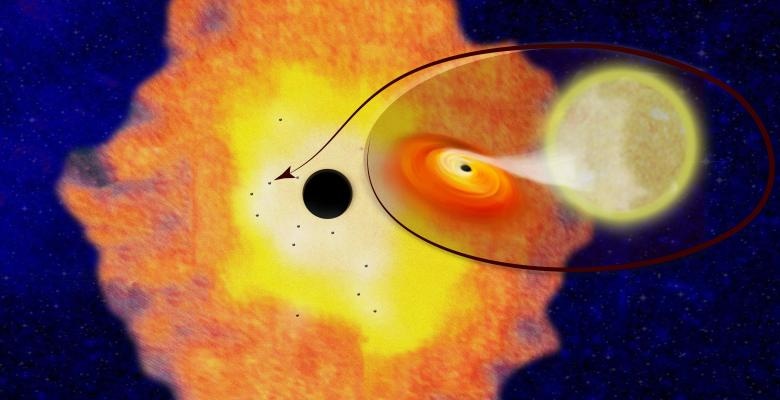Apr 5 2018
A team of astrophysicists led by Columbia University have spotted a dozen black holes grouped around Sagittarius A* (Sgr A*), the supermassive black hole in the center of the Milky Way Galaxy. The finding is the first to back up an ancient prediction, opening up innumerable opportunities to better comprehend the universe.
 Columbia astrophysicists have discovered 12 black hole-low mass binaries orbiting Sgr A* at the center of the Milky Way galaxy. Their existence suggests there are likely about 10,000 black holes within just three light years of the Galactic Center. (Image credit: Columbia University)
Columbia astrophysicists have discovered 12 black hole-low mass binaries orbiting Sgr A* at the center of the Milky Way galaxy. Their existence suggests there are likely about 10,000 black holes within just three light years of the Galactic Center. (Image credit: Columbia University)
Everything you'd ever want to learn about the way big black holes interact with little black holes, you can learn by studying this distribution. The Milky Way is really the only galaxy we have where we can study how supermassive black holes interact with little ones because we simply can't see their interactions in other galaxies. In a sense, this is the only laboratory we have to study this phenomenon.
Chuck Hailey, Co-Director of the Columbia Astrophysics Lab & Lead Author
The research paper was published in the April 5 issue of Nature.
For over twenty years, researchers have searched unproductively for proof to back up a theory that numerous black holes surround supermassive black holes (SMBHs) at the center of large galaxies.
There are only about five dozen known black holes in the entire galaxy - 100,000 light years wide - and there are supposed to be 10,000 to 20,000 of these things in a region just six light years wide that no one has been able to find. There hasn’t been much credible evidence.
Chuck Hailey, Co-Director of the Columbia Astrophysics Lab & Lead Author
He explained that Sgr A* is walled by a halo of gas and dust that offers the ideal breeding ground for the birth of enormous stars, which live, die, and could turn into black holes there. Furthermore, black holes from outside the halo are said to fall under the impact of the SMBH as they lose their energy, causing them to be pulled into the surrounding area of the SMBH, where they are confined by its force.
While most of the confined black holes stay remote, some capture and bind to a passing star, creating a stellar binary. Researchers are certain that there is a heavy concentration of these isolated and mated black holes in the Galactic Center, developing a density cusp which becomes more crowded as distance to the SMBH reduces.
In the past, failed efforts to discover evidence of such a cusp have concentrated on seeking the bright burst of X-ray glow that ensues when black holes mate with companion stars.
“It’s an obvious way to want to look for black holes,” Hailey said, “but the Galactic Center is so far away from Earth that those bursts are only strong and bright enough to see about once every 100 to 1,000 years.” To spot black hole binaries then, Hailey and his colleagues understood they would need to search for the fainter, but steadier X-rays discharged after the preliminary bonding, when the binaries are in an inactive state.
“It would be so easy if black hole binaries routinely gave off big bursts like neutron star binaries do, but they don’t, so we had to come up with another way to look for them,” Hailey said. “Isolated, unmated black holes are just black -- they don’t do anything. So looking for isolated black holes is not a smart way to find them either. But when black holes mate with a low mass star, the marriage emits X-ray bursts that are weaker, but consistent and detectable. If we could find black holes that are coupled with low mass stars and we know what fraction of black holes will mate with low mass stars, we could scientifically infer the population of isolated black holes out there.”
Hailey and colleagues sought archival data from the Chandra X-ray Observatory to test their method. They hunted for X-ray signatures of black hole-low mass binaries in their inactive state and were able to locate 12 within three light years, of Sgr A*. The team then examined the properties and spatial distribution of the identified binary systems and extrapolated from their observations that there must be somewhere from 300 to 500 black hole-low mass binaries and around 10,000 isolated black holes in the area adjacent Sgr A*.
“This finding confirms a major theory and the implications are many,” Hailey said. “It is going to significantly advance gravitational wave research because knowing the number of black holes in the center of a typical galaxy can help in better predicting how many gravitational wave events may be associated with them. All the information astrophysicists need is at the center of the galaxy.”
Hailey’s co-authors on the paper include: Kaya Mori, Michael E. Berkowitz, and Benjamin J. Hord, all of Columbia University; Franz E. Bauer, of the Instituto de Astrofísica, Facultad de Física, Pontificia, Universidad Católica de Chile, Millennium Institute of Astrophysics, Vicuña Mackenna, and the Space Science Institute; and Jaesub Hong, of Harvard-Smithsonian Center for Astrophysics.